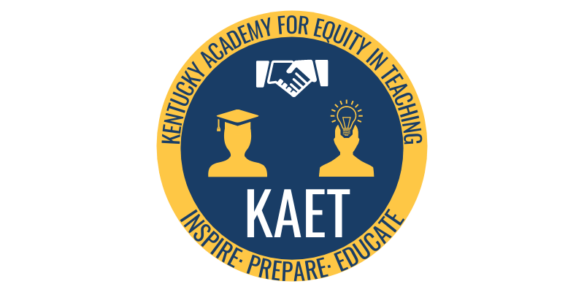
On March 4, Gov. Andy Beshear, Lt. Gov. Jacqueline Coleman, Commissioner of Education Jason E. Glass and other state education leaders announced the relaunch of the Kentucky Academy for Equity in Teaching (KAET), a statewide initiative to recruit and retain a more diverse workforce of teachers.
The academy is a partnership between the Kentucky Department of Education (KDE), the Kentucky Council on Postsecondary Education (CPE), the Kentucky Board of Education (KBE) and the Kentucky Education and Workforce Development Cabinet.
“This initiative will help us to recruit, develop and retain a highly effective, diverse and culturally competent workforce of teachers and school leaders,” Gov. Beshear said. “This is an urgent goal for the success of every Kentucky student, school, district and community, and I am committing state funding for this effort.”
The academy will focus on three areas: to Inspire, Prepare and Educate the future and current teacher workforce. The initiative aims to provide grants, mentoring, coaching and training, as well as support for recruitment while working to expand pathways to educator certification.
“Educators are given the wonderful responsibility of helping shape the future of the commonwealth by serving our children,” Glass said. “But we have too few people wanting to become teachers and too many teachers leaving the field shortly after they start. We especially have too few people of color, too few men and too few individuals from lower-income backgrounds currently in the teaching profession. It’s important for our students to see people who look like them at the front of a class, whether we are talking about race, ethnicity, economic background, disability or gender.”
Almost 61% of Kentucky’s student population last school year was considered economically disadvantaged. According to KDE statistics, during the 2019-2020 school year, about 25% of students identified as a race other than white, while only about 5% of teachers identified as non-white.
“Research has shown that when students see a teacher who looks like them or shares their background, they do better in the classroom,” said Thomas Woods-Tucker, Kentucky’s deputy commissioner of education and KDE’s first chief equity officer.
Diversity in the profession can lead to increased student achievement, lower dropout rates and other positive outcomes, including increased aspirations to attend a postsecondary institution. All students benefit socially when they have role models from a wide array of backgrounds, making them better local and global citizens.
“Every student in the commonwealth deserves equitable access to excellent educators who have unique experiences and perspectives and are committed to their success,” said Lt. Gov. Coleman. “Kentucky’s education leaders, and we as educators, have a shared responsibility in ensuring that this becomes a reality. Together, with deliberate action and shared commitment, we can deliver on that promise.”
Aaron Thompson, president of the Council on Postsecondary Education, said that to accomplish this, removing barriers to recruitment and creating opportunities for successful completion of college educator preparation programs is vital.
“Equity in our teacher workforce is one of the most important ways we can demonstrate our values to the next generation,” Thompson said. “It helps expose students to a rich and diverse learning environment and allows every student to perceive their stake in our educational system. The effect is clear: Greater equity in our teacher preparation programs sets the stage for greater college attainment among all of our students.”
While recruiting people to become teachers has long been a challenge, difficulty retaining current teachers has made it even harder to maintain a diverse workforce. Data show that over the past two and a half decades, minority teachers were more likely to depart from their schools than non-minority teachers. This was especially true for male minority teachers.
KAET seeks to address all of these issues through its “Inspire, Prepare and Educate” approach. The tools it will use to do this are:
- Inspire:
- Launch a “grow-your-own” grant program. This competitive grant program will provide funds to establish partnerships between school districts and postsecondary institutions to develop a pipeline of promising educators.
- Prepare:
- Provide mentoring and assessment coaching for participating students. These students will receive individualized support in developing a study plan, and strategies for success in admission to an educator preparation program. They also will receive reimbursement for assessment-related expenses, and the academy will provide them with personal guidance throughout their high school and college careers and beyond.
- Develop a system of supports for recruiting and supporting prospective teacher candidates and expand programs that support high-quality alternative pathways to certification to focus on increasing teacher diversity.
- Educate:
- Develop a research-based series of cultural competency and equity modules that include unconscious bias training. These modules will be available to all Kentucky public educators to assist in developing more effective and equitable strategies to meet the needs of all students.
- Host focus groups. These will help develop a strategic plan to support the recruitment and retention of a diverse educator workforce.
“Grow-your-own” programs are important, as 60% of America’s teachers work within 20 miles of where they went to high school.
“There are no better recruiters for the profession than current educators themselves,” said Sharon Porter Robinson, vice chair of the Kentucky Board of Education (KBE).
Two of KBE’s five goals relate to diversifying the educator workforce and promoting equity and anti-racism.
Lu Young, chair of the KBE, noted the program will help achieve these goals by further developing and expanding Kentucky’s Teaching and Learning Pathway in high schools.
The Teaching and Learning Pathway is designed to introduce high school students to the field of education and lay a foundation allowing those students to transition into postsecondary studies.
The pathway will be paired with local chapters of Educators Rising, a career and technical student organization that gives students a solid foundation for career preparation in education.
“Students who receive formalized training in the classroom while participating in Educators Rising develop leadership skills and positive personal attributes,” Young said. “It also helps them learn to apply their skills in the real world.”
KDE will have more information on KAET as the initiative moves forward. Be sure to check KDE’s website and the KAET webpage often for more information.




Until our state makes a college education more affordable and increases teacher pay for both beginning teachers and those who stay in the profession, we will continue to have low recruitment numbers. We cannot justify spending $100,000 or more on an education and getting a job with an average starting pay of around $35,000-$40,000 per year and never reaching a salary even close to $100,000. I was very blessed to graduate college debt-free through grants, scholarships, and my parents help, but most people do not have that opportunity. I have taught for over 23 years in one of the highest-paying districts and my salary will never reach even close to 6 figures. Men in this profession cannot make enough money to provide for their families, and that reason is one of the main ones of why there are not more men in this profession. I love teaching; I just wish we were truly appreciated. We get much lip service from our leaders but little action.